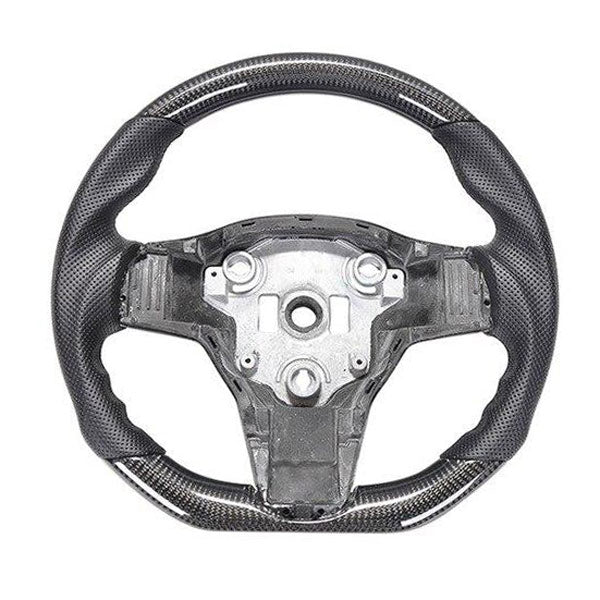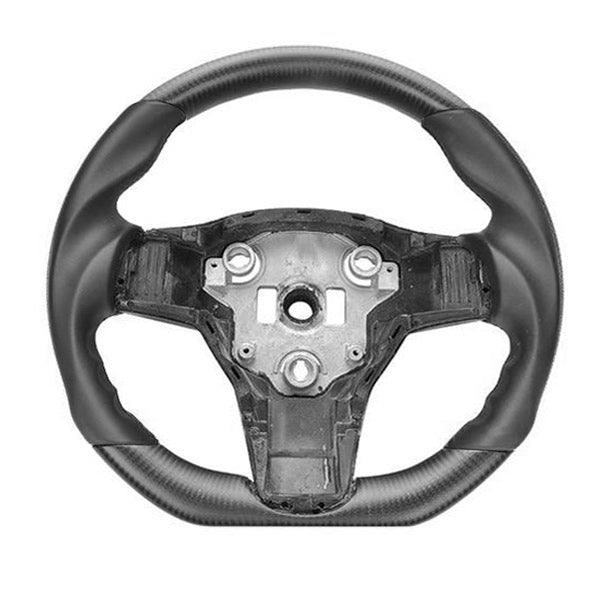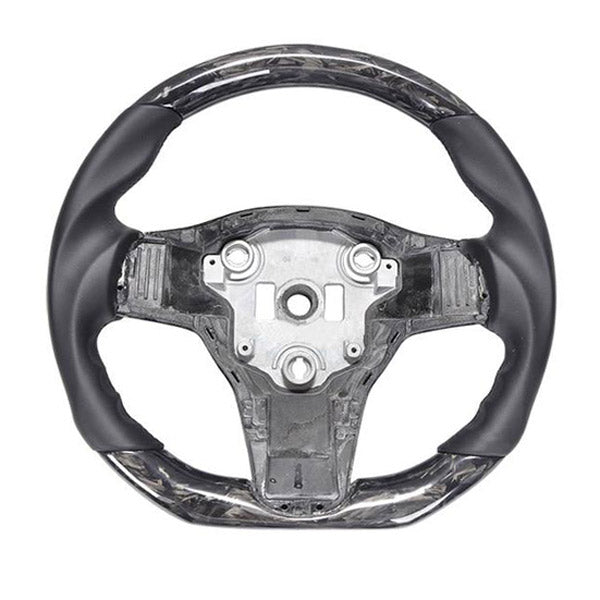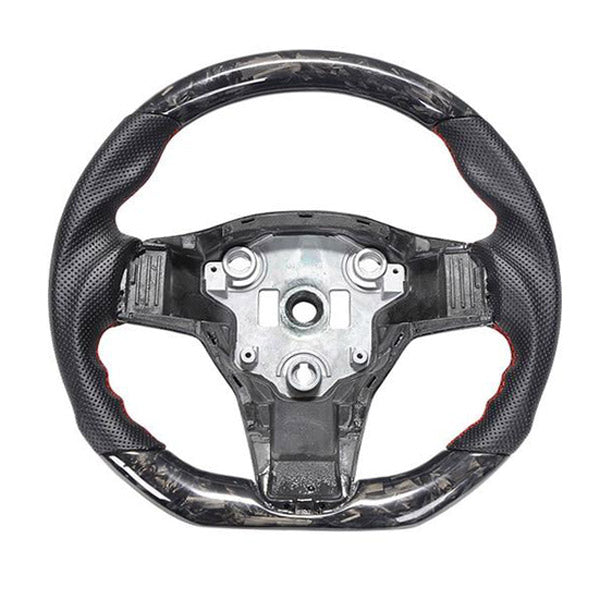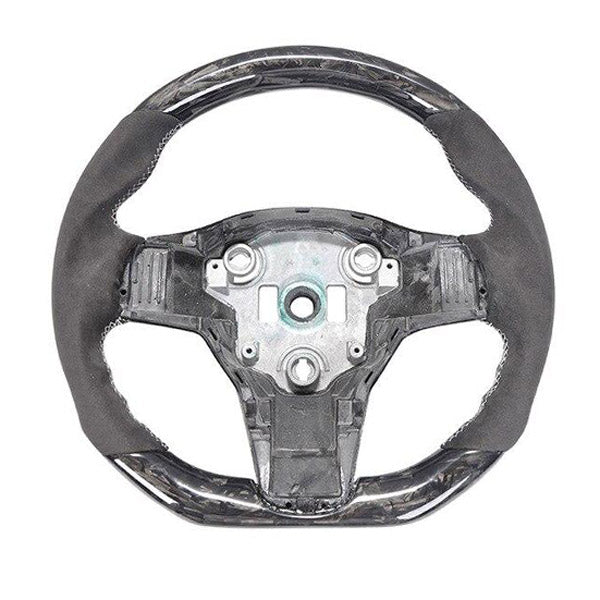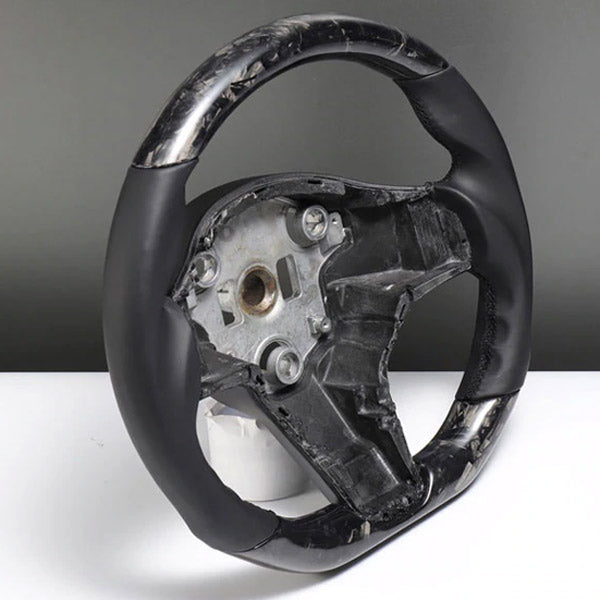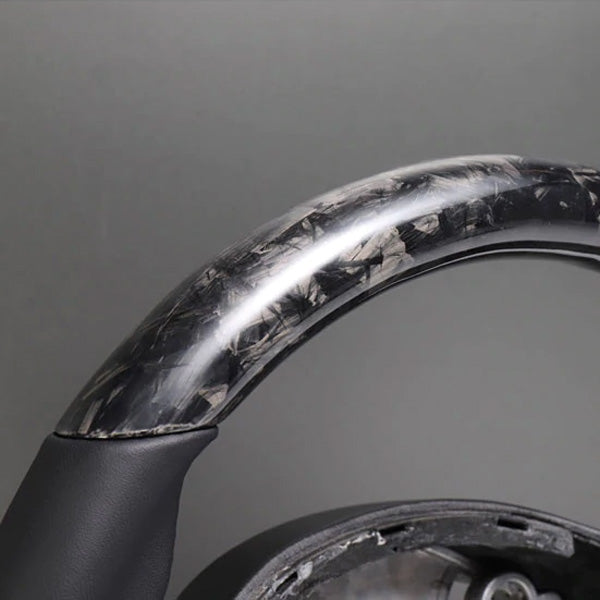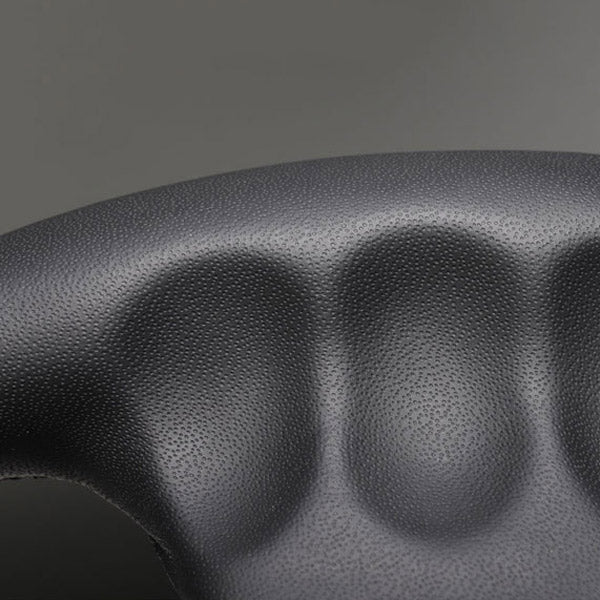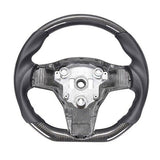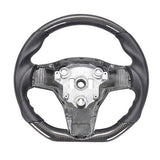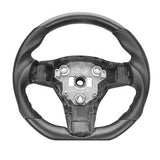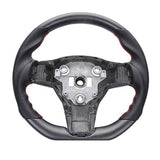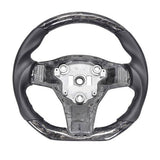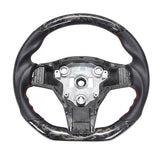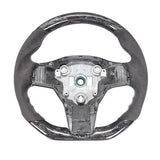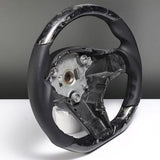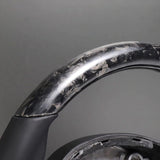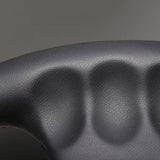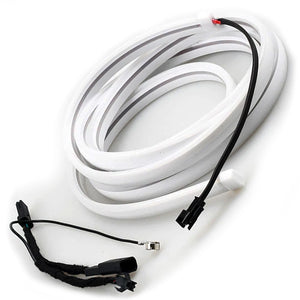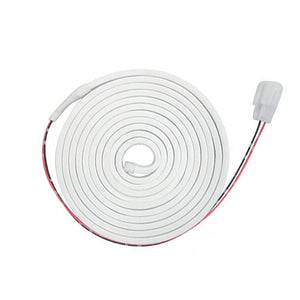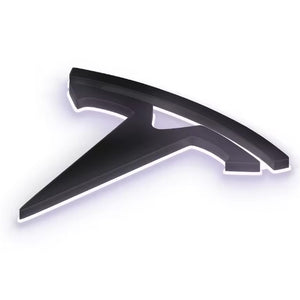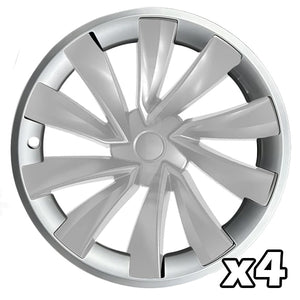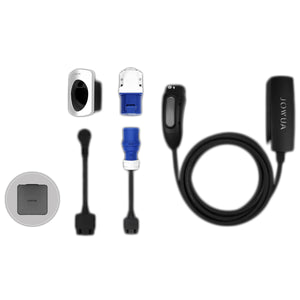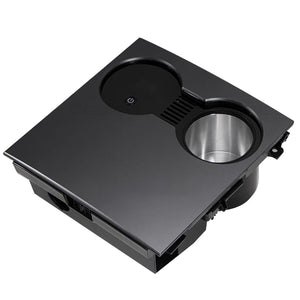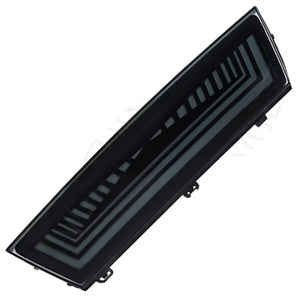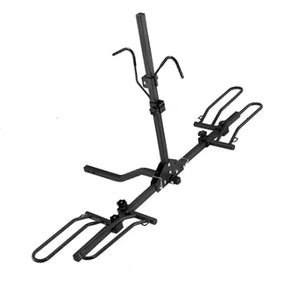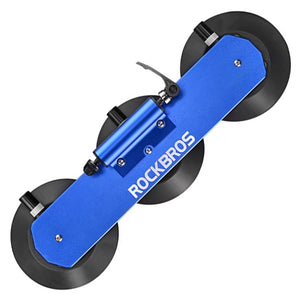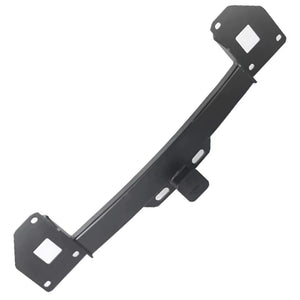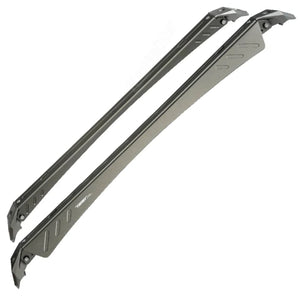Carbon steering wheel
Tesla Model 3 - Y
The leather/Alcantara and carbon mix for a totally radical style in your Model 3 or Y. A steering wheel that will add the finishing touch to your Tesla without overdoing it!
The version that keeps the original design while changing the finish
This version of the steering wheel keeps the original proportions of the steering wheel of your Model 3 or Y while changing its appearance.
Only the grip will be different with work done on the shape of the parts in leather or Alcantara® (your choice).
You can choose the color of the leather or the Alcantara® according to your wishes, the latter perhaps in the color of your door panels (anthracite grey).
Characteristics of the carbon steering wheel for Tesla Model 3 or Y
Made to measure, just for you. After ordering, we will organize a telephone appointment to know exactly your preferences.
During this telephone meeting, we will take note of the year and month of registration, the presence or not of the heated steering wheel option, the marking at 12 o'clock or not and other details.
- Outstanding design: Change the look of your Tesla
- Installs instead of: OEM Tesla refurbished part, the internal structure is not modified
- Sold without button trim and without airbag cover
- Quality materials: leather/Alcantara® formed and sewn by hand
- Year of correspondence: Model 3 and Y version 2017-2020 and 2021-2023
-
2 year warranty
_________
Model Sport, the company that promotes a process for developing carbon parts, but which one? Composite material: its designation? A carbon part: what is its interpretation?
Let's develop these ideas around three main axes:
• It is eminent to look once and for all at what carbon really is
• What makes Model Sport an experienced brand to work in the field
• Anything you can customize
The product will have no more secrets for you as soon as you have explored this paragraph.
What is a composite material?
A composite material is an alliance of two elements which cannot be associated with each other in a homogeneous way, but together they give a material with improved mechanical properties.
What are the types of carbon or Texalium for your Tesla?
In fact, there is a large catalog of carbon grades and many ways to work with them.
A distinction must be made which will be important for purists: what is commercially called "carbon" actually has the name "carbon fiber composite", it should be noted that in the field of lamination, it is this term that is used.
200 gram twill 3K carbon membrane:
Let's start with the most familiar of carbon fiber composites, 3K carbon in twill mesh. In other words, what is called "twill" is a name given to a certain way of weaving carbon.
You can see what the twill describes in the image just above. One of the arguments for the intense use of twill is undoubtedly its manageability: it is able to take the shape of almost any architecture.
That said, we will not detail the type of intersection in 3/1, 2/2 and 4/4.
The sign annotated "3K" characterizes the total number of strands that make up a single carbon frame, in total unit: 3000 filaments.
1/20th the thickness of a hair: this is an order of magnitude that will let you know the diameter of a single carbon filament.
To designate and name the most common types of carbon used in the different fields of industry, we must mention 1K, 3K, 6K and 12K. The 3K is the most popular in the Tesla world. As for the weight stated when selling a carbon sheet, if it is indicated "200gr/m²", this establishes the weight that 1m² of this sheet weighs before it is confused with a resin.
The combination of carbon characteristics that you come across the most is the twill weave in 3K and 200gr/m², not for its mechanical properties, but more for its aesthetics and its widespread application in many industries, which makes it cheap.
The unknown in its class: forged carbon
We may think that this name of "forged carbon" is commercial or overused, however, its production process requires equipment and implementation techniques that are already a few years old and above all, which really make it more efficient.
To give you a simplistic designation, so-called "forged carbon" refers to a unique production process: the carbon fiber is cut into small pieces and then dispersed evenly in a mold. At this, the resin is spread for the whole is enclosed (the positive mold and the negative) and then put under compression by increasing the temperature of the latter.
This molding technique is the most sophisticated to obtain a stiffer and lighter part than any other type of carbon: all the excess resin is evacuated during compression, so you can increase the carbon/resin ratio in favor of carbon.
Lamborghini is the pioneer in the use of forged carbon in the automotive field. However, it should be known that forged carbon has been used in the production of warheads since the 1980s.
Texalium, the unusual:
Often confused with carbon, Texalium is a material in its own right that deserves its place in this determination.
It is in order to acquire the desired appearance that this material is in truth fiberglass loaded with aluminum, the resin or the varnish will then be nuanced to give it a specific color.
You should know, however, that its mechanical properties are less than those of a usual glass fabric. And its application is purely aesthetic.
Be aware that Texalium is a material that has existed for years, but is little used in France. It is also much more widespread and on the Atlantic side.
What does carbon look like visually?
With carbon fiber, what exactly can you make?
We make quotes on request if you ever have a specific project in mind.
What is the endurance of carbon?
It is legitimate to wonder if the resistance of the material is up to the task, but compared to what? In truth, it is more accurate to wonder about the possible comparisons with other materials.
To give you an idea: an aluminum alloy that has a physical volume equal to a carbon part will be less durable than the latter, all stresses combined. It is important to come back to the term “resistant”, because it means everything and nothing.
Even if carbon is less resistant to impacts, it has exceptional qualities when torsion or bending. It is for this justification that for Tesla automobiles it is so common to produce ultra-thin carbon inserts which are fixed on existing parts without risk of breakage.
The Model 3 or Y dashboard insert is a good example. Only two layers of carbon fabric are used to develop a 1m40 long piece, which will be shipped throughout France without suspicion of breakage.
Carbon fabric and its purchase price?
What is interesting to explain in order to assimilate the price of carbon, it is necessary to go back to the manufacturing operation of this one.
The technique of shaping a carbon frame is already relatively complicated. To roughly characterize the stages of making a single carbon fiber, you have to start your work with a synthetic fiber called polyacrylonitrile, it will be put under oxidation then then logically calcined to offer us this inimitable carbon fiber. .
The awareness of more and more carbon fiber production industries gives rise to certain projects, essentially directed with the aim of producing it using as few chemicals as possible. It is increasingly recommended to eradicate chemicals and to reduce prices, sometimes even by two, to use biosourced materials.
Also bear in mind that the equipment required to make even a single piece of carbon fiber is quite expensive in every sense of the word. A carbon fiber is 20 times smaller than a human hair, that's what you have to remember. To give you a price, which remains indicative, because it is subject to variations in the world economic price: €30 per square meter.
This price is given for a 3K twill carbon ply that weighs 200gr per square meter.
You must also consider the price of the resin used and the number of tablecloths to be laid. Finally, a qualified laminator must be used to install the product. Moreover, the operation must be carried out under specific conditions.
The carbon dissimilarities of Tesla Model Sport
Mastering the stages of production is important to know the finished product, which is why we are discussing this subject.
In the field of the production of carbon parts, the creator of the company Model Sport, François SPITALS, implements all his knowledge in the field of design and creation of automobile bodywork to provide the best in terms of finishing.
A carbon weave or a laminated version?
It is an indisputable fact, in the 21st century carbon is mainly used for its finish, more than for its primary application: its mechanical abilities and its lightness.
No stress, the majority of the time, will be subjected to the components installed on your Tesla. The components are expressly manufactured in order to improve the aesthetics and highlight the aggressiveness of the brand. It should be understood that even in the case of body kit for Model S, 3, X or Y or any other automobile aiming to run on the circuit, the opposites generated on the latter will be supported by the lowest carbon range (so that there are some designated as low-end).
However, there are multiple categories that will define the stiffness of carbon, the most common being HR (high resistance) because it is the most flexible and versatile. For all the carbon parts of your Tesla, Model Sport is also based on this type of carbon which is very widespread and so practical on a multitude of points.
It differs from HM (High Modulus) which will certainly be lighter, but also much more brittle, so much so that it almost always has to be combined with HR. The reference we can bring concerns forged carbon: it is usually used for its appearance, however its primary purpose is extraordinary resistance.
Does the resin used play a role in the quality of the finished part?
Here we enter the most interesting area of this description: resin.
The mass production of certain carbon elements is generally produced with polyester resin. It is inexpensive and withstands high heat fairly well. To give you an illustration, polyester is used for the production of carbon cartridges for motorcycles.
With regard to the production of carbon parts subject to potential loads, the Epoxy resin will provide the entire composite material with greater resistance. We consciously use, after many tests, Epoxy resin, and not just any resin: this one includes an anti-UV treatment which will allow it not to tarnish or yellow over time.
The aggressions of UV rays emitted by the sun will therefore have no effect on your carbon parts, what is more, the appearance is more transparent. This is a particularity that will only be felt several years after installation, but if the anti-UV treatment is not present, beware of yellowing of the parts.
It will be perfect during installation, but beware of periods of heat wave, otherwise you will notice a yellowish and opaque appearance in a few years.
The behavior over time is a determining point to know the price of a resin, as well as its production quality and its field of application.
Although the price may vary depending on the manufacturers and retailers, it is eminent to make a comparison on French territory between these different resins:
• The kilo of Polyester resin is worth between 8 and 10€
• 55 to 65€ for the kilogram of anti-UV Epoxy resin
What is the topcoat on a carbon part?
Varnish is the end point of a carbon part. In the interests of ultimate quality, we had produced parts without topcoats at the very beginning, which required uncompromising production quality the first time around.
Tesla's nerve center is to promote pollution reduction, so the high scrap rate of this production technique was ultimately a problem. We therefore use superior quality varnishes to "standardize" the finish of our carbon parts.
Once the glossy varnish has been applied, it will be carefully buffed to give it a polished surface. The mat, which does not benefit from any possible recovery thanks to polishing, is carried out by a professional painter in one go.
The kind of carbon on Tesla S and X vehicles
At first glance, both vehicles have all of their interior components similar. However, a certain number of parts remain quite distinct depending on the year of registration.
Don't be surprised to receive a call after ordering to find out the year and month of registration of your vehicle.
Tesla S or X interior trim
The Model S and X have been forgotten by props since the launch of the Model 3, however these also benefit from a range of upgrades provided.
The real carbon will be used to modify the dashboard, the areas around the center console or even other components to come in the future.
The carbon steering wheel is also one of the reworkable parts that will give a different dimension to your life on board your Tesla. So you keep control when ordering the choices that best suit your desires.
Model S and X: bodywork components
The performance spoiler for the Model S is the most sought after for the latter. Always keen to make a difference, the matt Performance spoiler will benefit for the Model Sport version from a reworked bonding surface and a lighter internal structure.
This change is subtle, so much so that it won't be visible once the spoiler is installed, however these details make all the difference. At the time of writing, the Plaid version of the new Model S is also being manufactured.
The grille and the mirror caps are also parts that will receive their carbon finish. Generally in a glossy or matt finish, the carbon will in most cases be 3K twill, however if you want a creation based on Texalium or forged carbon, send us a request directly by phone or email, we can provide you with a personalized quote for your Model S or X.
Carbon realizations on Model 3 and Y
The most modified electric vehicle of all time is undoubtedly the Tesla Model 3, which receives an incredible number of carbon-based modifications.
Let's take a look at the similarities with the Model Y, which shares a lot of carbon accessories.
What's inside the Model 3 and Y
We can't talk about Model 3 and Y without mentioning the carbon inserts, which have become part of the Tesla culture.
It's an exercise in strength to be able to develop in series carbon elements that can cover a part while giving the impression that there is no addition.
It is on this assumption that the quality of an insert must be judged. It is after many trials, errors and rectifications that we now produce inserts that meet your expectations.
What defines the precision of an insert lies in the meticulousness of its cutting, as well as in the overall shape taking into account an ultra-thin double-sided in order to pose as close as possible to the elements.
But you can just as easily opt for a real carbon replacement element, which will be positioned directly in place of the changed part. The fine production of these elements will give you real carbon works of art in your vehicle.
Model 3 and Y: their body components
The bodywork of the Model Y or 3 is not to be outdone with a good number of possible carbon-based tune-ups. A good way to transform the external visual aspect, with a composition in 3K twill or forged, and matte or glossy finish.
As far as the Model 3 and Y are concerned, the performance spoiler in its matte version is quite busy. An element that has become a standard over time, the spoiler will come to rest on the edge of the trunk to give your Tesla its sporty side.
You can also choose more daring modifications like the real carbon front cover, an absolutely magnificent piece that will effectively give you weight loss, while keeping its use fully functional.
- 🇫🇷 Gestionnaire Français
- Commandez directement au Fabricant ou au Distributeur
- Payez que votre produit (pas de frais de stockage ni de taxe territoriale)
- Livraison dans toute l'Europe !
Vous remarquerez que le bouton au-dessus vous redirige vers un des distributeurs ou fabricants du produit.
La major partie des accessoires Tesla proviennent de Chine, commander via les plateformes Aliexpress, Alibaba, Amazon, Hansshow ou Jowua vous donnera la possibilité d'obtenir le produit sans intermédiaire.
Les produits vendus en France ou en Europe proviennent du même fabricant Chinois (ou autre), mais avec une marge supplémentaire servant à payer les frais de fonctionnement de la société.
Cependant, l'avantage de commander à proximité est d'obtenir un délai de livraison plus rapide (néanmoins nous proposons aussi des produits expédiés directement depuis des stock Français ou Européens)
Model Sport a initialement commencé en faisant du stock en France, nous connaissons donc quels sont les fabricants de confiance et leur méthode de travail. Si bien que nous les citons avec leurs accords : MAOFA, BFB carbon, Yute Technologie, DCR Tuning, LITA Accessories, Jogon, Ever carbon, Carbonss Tuning, Jowua.
Ces fabricants, parmi quelques autres, sont les plus actifs et sérieux dans leur qualité de fabrication. Nous vérifions que les produits proviennent systématiquement de notre liste de fabricant. Ainsi, que vous commandiez via un distributeur Aliexpress, Amazon ou autre, nous savons que le produit sera de bonne facture.
